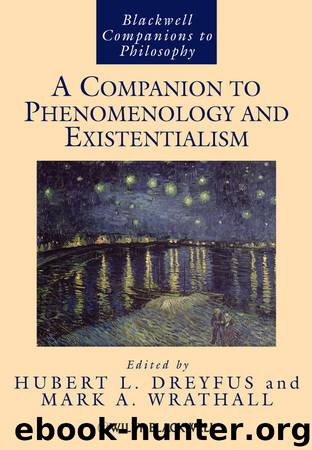A Companion to Phenomenology and Existentialism by Dreyfus Hubert L.; Wrathall Mark A.; & Mark A. Wrathall

Author:Dreyfus, Hubert L.; Wrathall, Mark A.; & Mark A. Wrathall
Language: eng
Format: epub
Publisher: Wiley
Published: 2010-08-05T16:00:00+00:00
Notes
1 For instance, Paul Churchland and Richard Rorty in an earlier incarnation.
2 I have defended this in Solomon 2005.
3 I find it particularly revealing that James juxtaposes his chapter on “Emotions” in his Principles (vol. 2) just after the chapter on “Instinct” and not with his chapters on perception and cognition. See James 1950.
4 On this point, see the very analytic treatment of emotions with reference to possibility in Gordon 1987.
5 For instance, see Izard 1974.
6 By “active” engagement I do not mean to deny that a great many emotional reactions seem to us passive in nature, or that the circumstances that provoke emotion often happen to us, or that the mode of emotional expression (and therefore emotional experience) is often passive, as in passive-aggressive behavior.
7 See, for instance, Griffiths 1997. For an impressive rebuttal, see Charland 2002.
8 This is the family of emotions and the set of characteristics defined, for example, by Paul Ekman in his very influential writings on the subject (see Ekman 1994, 1999). Ekman goes on, however, to define “emotion” in terms of just this class.
9 See also Gurwitch 1966.
10 Debates about the self-consciousness of “higher” animals and the very meaning of “self-consciousness” have been ferocious and frequent, beginning with the Stoics and then at least since Descartes (and Sartre) denied that animals were capable of developing such capacities. In contemporary ethology, animal behavior researchers have generally attributed self-consciousness to chimpanzees and dolphins, some have extended this to elephants, gorillas, dogs, and cats, but a few have broadened the concept such that it applies not only to domestic animals but, at the far reaches, any creature that is capable of orienting itself in the world. (Lewis Thomas suggests that even slime molds have self-consciousness in that they recognize those that are or are not themselves, that is, the result of their own asexual reproduction).
11 In the article referred to above, Carroll Izard defines emotion as a “brief . . . response” (Izard 1974: 248). Joseph Le Doux similarly insists that an emotion as such is only the distinctive neurological (amygdala) response and not at all the intellectual (cerebral) subsequent activity (Le Doux 1996).
12 For example, Marcel and Lambie 2002.
13 The phrase “affect program” comes from Sylvan Tompkins but was popularized by Paul Ekman in his work on “basic emotions.”
14 The main psychologist in question is Nico Frijda (see Frijda 1986). The psychiatrist-philosopher is George Downing (see Downing 2001).
15 Thanks to John Deigh for this Shakespearean reminder.
Download
This site does not store any files on its server. We only index and link to content provided by other sites. Please contact the content providers to delete copyright contents if any and email us, we'll remove relevant links or contents immediately.
| Deconstruction | Existentialism |
| Humanism | Phenomenology |
| Pragmatism | Rationalism |
| Structuralism | Transcendentalism |
| Utilitarianism |
The remains of the day by Kazuo Ishiguro(7551)
Tools of Titans by Timothy Ferriss(6946)
The Black Swan by Nassim Nicholas Taleb(6190)
Inner Engineering: A Yogi's Guide to Joy by Sadhguru(5895)
Giovanni's Room by James Baldwin(5878)
The Way of Zen by Alan W. Watts(5799)
The Six Wives Of Henry VIII (WOMEN IN HISTORY) by Fraser Antonia(4790)
The Power of Now: A Guide to Spiritual Enlightenment by Eckhart Tolle(4755)
Astrophysics for People in a Hurry by Neil DeGrasse Tyson(4620)
Asking the Right Questions: A Guide to Critical Thinking by M. Neil Browne & Stuart M. Keeley(4574)
12 Rules for Life by Jordan B. Peterson(3734)
The Ethical Slut by Janet W. Hardy(3502)
Skin in the Game by Nassim Nicholas Taleb(3460)
Housekeeping by Marilynne Robinson(3401)
The Art of Happiness by The Dalai Lama(3384)
Double Down (Diary of a Wimpy Kid Book 11) by Jeff Kinney(3272)
Skin in the Game: Hidden Asymmetries in Daily Life by Nassim Nicholas Taleb(3264)
Walking by Henry David Thoreau(3234)
12 Rules for Life: An Antidote to Chaos by Jordan B. Peterson(3200)
